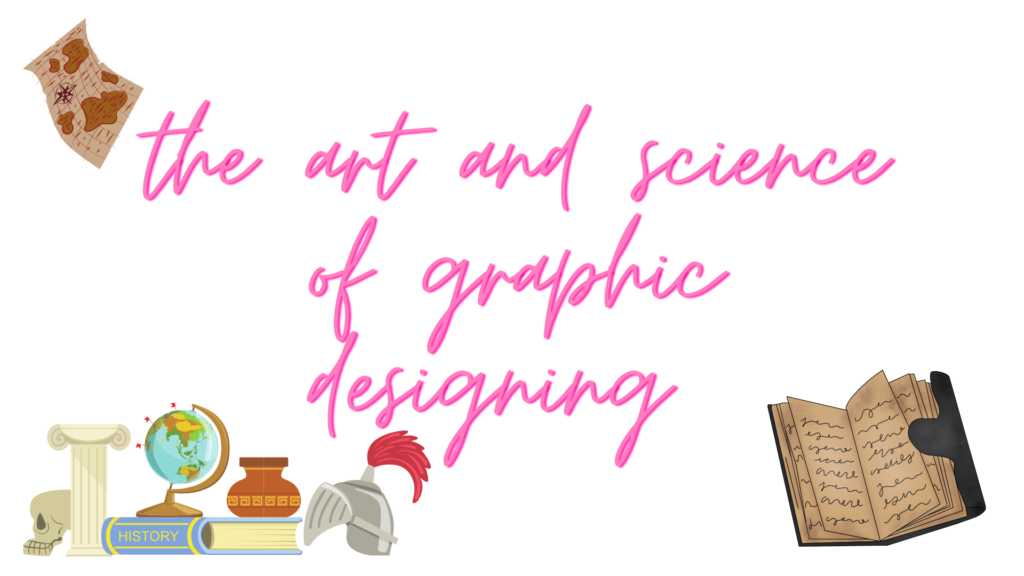The art and science of Graphic design is a powerful tool that shapes our visual world. From the logos we see on our favorite products to the layouts of our favorite websites, graphic design is all around us. It is both an art and a science, combining creativity with technical skills to communicate messages visually.
read more about graphic design
The history of graphic design

The origins of graphic design can be traced back to early human history. Ancient civilizations used symbols and drawings to communicate and document events. The invention of the printing press in the 15th century revolutionized the field, making it possible to reproduce texts and images on a large scale.
The 20th century saw the birth of modern graphic design as we know it. With the rise of advertising and mass media, the need for professional graphic designers grew. Movements like Bauhaus and Art Nouveau significantly influenced design principles, emphasizing simplicity, functionality, and aesthetics.
key principles of graphic design
Several fundamental principles guide graphic design, helping designers create visually appealing and effective work:
1.Balance: Achieving visual equilibrium in a design by distributing elements evenly. Balance can be symmetrical or asymmetrical.
2.Contrast: Using differences in color, size, shape, and texture to create visual interest and draw attention to key elements.
3.Emphasis: Highlighting the most important part of a design to ensure it stands out.
4.Unity: Ensuring all elements of a design work together cohesively, creating a sense of harmony.
5.Alignment: Arranging elements in a way that creates a visual connection between them, improving readability and organization.
6.Repetition: Using the same or similar elements throughout a design to create consistency and reinforce the visual theme.
Tools and techniques
Graphic design is a field that requires a blend of creativity and technical skills. Designers utilize a range of tools and techniques to bring their visions to life. Here is an overview of some essential tools and techniques used in graphic design:
Tools used in graphic designing
1. Adobe Creative Suite
– Photoshop: Widely used for photo editing, retouching, and creating digital art. It allows designers to manipulate images, adjust colors, and create complex compositions.
– Illustrator: A vector graphics editor ideal for creating logos, icons, illustrations, and scalable graphics. It’s renowned for its precision and versatility.
InDesign: Primarily used for layout design in print and digital publishing. It’s essential for creating brochures, magazines, books, and other multi-page documents.
2. Sketch
A popular tool for web and mobile UI/UX design. It offers vector editing, prototyping, and collaborative features that make it a favorite among app and web designers.
3. Figma
A web-based design tool known for its collaborative features. It’s excellent for UI/UX design, allowing multiple designers to work on a project simultaneously and share feedback in real-time.
4. Procreate
– A digital painting and illustration app for iPad. It’s favored by illustrators and digital artists for its intuitive.
Type of graphic design
- Visual Identity Graphic Design
Visual identity graphic design focuses on the visual elements of a brand or organization. This includes creating logos, typography, color palettes, and other design elements that represent the brand’s personality and values.
2.Marketing and Advertising Graphic Design
This type of design is used to promote and sell products or services. It encompasses a wide range of materials and mediums, from print advertisements to digital campaigns.
3. User Interface (UI) Graphic Design
UI design focuses on the visual layout and interactive elements of digital products. It aims to create user-friendly and aesthetically pleasing interfaces.
4. Publication Graphic Design
Publication design is concerned with creating layouts and covers for printed and digital publications. This includes books, magazines, newspapers, and online articles.
5. Packaging Graphic Design
Packaging design involves creating the exterior of a product that is intended to protect, contain, and sell it. Effective packaging design not only protects the product but also attracts and engages.
6. Motion Graphic Design
Motion graphics involve creating moving visual elements. This type of design is used in video production, animation, and digital interfaces.
7. Environmental Graphic Design
Environmental graphic design involves the creation of visual elements in physical spaces. It enhances the user’s experience by making spaces more engaging and informative.
8. Art and Illustration for Graphic Design
This type of design merges fine art and graphic design, creating visually appealing artwork for various applications. It is often used in custom graphics for projects, including t-shirt designs, album covers, and book illustrations.
9. Information Graphic Design
Information graphic design focuses on presenting data and information in a visual format that is easy to understand. It involves creating infographics, charts, and diagrams.
